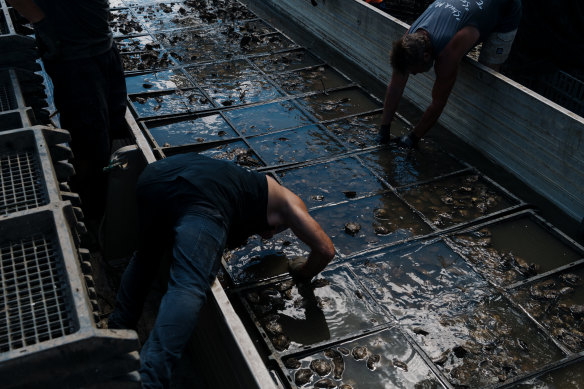
“At best, we are 12 months away from income coming in,” he said. “It is devastating to see. It is still a knife-edge in Port Stephens ... if we will pull through as an industry, it will only be a shadow of what it used to be for some time.”
A NSW Primary Industries spokesperson said the department undertook surveillance of Port Stephens and found QX to be present more widely across the estuary during August last year, which caused extensive losses in Sydney rock oysters there.

Oyster farmers have been battling years of floods that have affected supply, including Hawkesbury River Oyster Shed farmers Deb and Peter O’Sullivan who rushed to save their stocks in the March 2021 floods. Credit:James Brickwood
“Tracing and sampling was undertaken for oyster shipments that had occurred prior to the detection of QX in August 2021 in Port Stephens.
“No evidence was found of the spread of QX outside Port Stephens from this event,” the spokesperson said. “NSW DPI is continuing to work closely with the NSW oyster industry and affected oyster growers in response to this detection.”
Loading
Port Stephens MP Kate Washington said there were mountains of dead oysters in some areas.
“With little prospect of earning any income for at least another year, some oyster farmers have been forced to walk away from the only industry they’ve known,” she said. “I’ve been working alongside our local oyster farmers to get the support they need from the NSW government. We must ensure this important local industry survives.”
The disease was first confirmed in NSW in 1994, in the Georges River in Sydney, and hit the Hawkesbury River region in 2004, resulting in huge losses to Sydney rock oyster farmers.
Sydney Fish Market spokesperson Alex Stollznow said oysters indicate the health of waterways and can be some of the slowest species to recover after diseases or flooding events.
“Oysters and oyster farmers are used to closures of one kind or the other ... You will see a temporary dip in times of serious shortage – like the statewide floods and there were no Sydney rock oysters for six weeks – but the thing is, even if all of NSW shuts down, the other states can meet our local oyster demands,” he said.
He said there were almost 300 oyster farmers in NSW working on 32 coastal estuaries who would be able to meet demand.
The Morning Edition newsletter is our guide to the day’s most important and interesting stories, analysis and insights. Sign up here.









 Add Category
Add Category